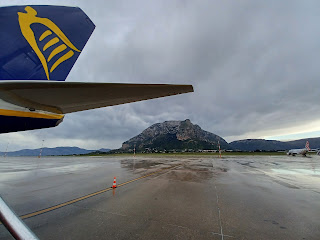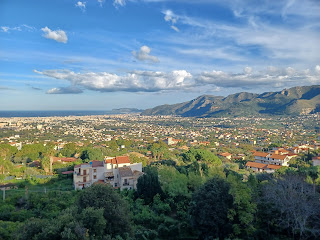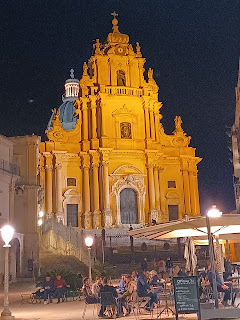Because the Palermo airport is located some distance away from the city center, we did something unusual to start our Sicily trip. Rather than land in Palermo and start our trip there, we decided to pick up the rental car and leave to explore the island. This allowed us to avoid a trip back to the airport to get a car or starting our road trip by picking up a car in the city. (We try to avoid driving in larger cities in Europe when possible ever since we nearly left a rental car on the sidewalk in Madrid in 2007 when we couldn’t find the car rental return location.) It turned out to be a good plan. By the time we got to Palermo, we were very comfortable with Sicily and the “big” city didn’t seem overwhelming.
The Palermo airport has a nifty surprise – when you walk down the stairs from (or to) the plane you are greeted by terrific rock formations:
In Palermo, we stayed at a fabulous B&B right in the center of the city with a terrific rooftop terrace where we ate breakfast each morning. Palermo has taken a step many European cities are trying – it pedestrianized its two main cross streets, which makes the city easy to navigate.
Palermo is filled with churches, and we explored a few. The Church of Santa Caterina’s interior was overdone as one expects of a Baroque church, but its three-dimensional marble inlay decorations were intriguing. It was easy to recognize the story of Jonah and the whale, as well as Abraham’s near sacrifice of his son Isaac.
We took a city bus out to the Monreale Cathedral to see one of the most ornate churches you’ll find anywhere. The interior of the entire cathedral is covered in golden mosaics. Built by William II, Sicily’s last Norman king, between 1174 and 1189, the cathedral is a mix of Byzantine, Norman and Arab elements in a Romanesque building. The exterior bronze doors were made by Bonanno Pisano, the architect of the Leaning Tower of Pisa. Inside are more than 68,000 square feet of mosaics, with Christ at the center looking down on everything. For perspective, in this mosaic, his right hand is over six feet tall.
The view down to Palermo from Monreale is spectacular.
Since Sicily was ruled by Spain at the time of the 1492 expulsion of the Jews, there are few remnants from the Jewish history of the island. In Siracusa, there is an ancient Jewish ritual bath that sits 18 meters below the city streets. In Palermo we discovered an old street sign written in Italian, Hebrew, and Arabic (which was apparently the norm prior to the end of the 15th century):
Palermo was an excellent way to finish out the trip. It has good food, interesting sites, and the best gelato (Dolce Capo). Sicily was a fabulous destination. Although we feel we were able to cover nearly all of it, we would definitely consider going back again.
This will be our last post of the year. Wishing you all health and joy as we put 2021 behind us. We hope that 2022 brings an end to the pandemic and new opportunities for adventure.
Ciao,
Shana & Jeff






















































